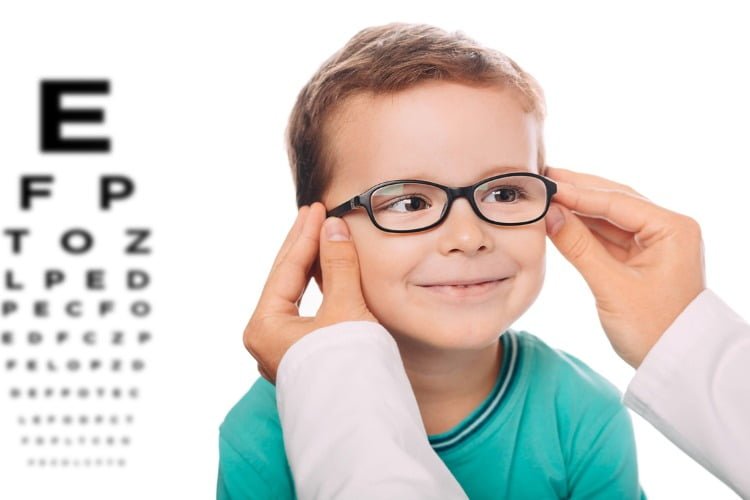Anita is a six year old bright and chirpy child who has just entered a formal school. Off late, her parents noticed that she was reluctant to go to school or do her homework. She complained of a headache every now and then. Her teachers also gave a feedback that she was quite inattentive in class and made a lot of mistakes while copying from the board.
Anita’s patents attributed all this to the transition from a pre-school to a formal school and a change of environment. They counselled her, scolded her and even punished her to set things right. But nothing seemed to work. In fact her behaviour and school performance followed a downward spiral.
Finally they took Anita to the pediatrician who advised them to get an eye check up from a pediatric ophthalmologist. She was detected to have an eye power and was advised glasses.
Voila…!!! All her issues vanished and she was back to her old chirpy and happy self.
This clearly demonstrates the important role of ‘clear vision’ in a child’s life.
Vision is the highest developed cognitive human potential and nearly 80% of learning happens through visual activities. According to the American Optometric Association,1-in-4 school-going children has a vision problem, 61% of parents mistakenly believe they would know if their child was having difficulty with their eyesight and 60% of students identified as problem learners have undetected vision disorders. Therefore, eye and vision care needs to be given the same level of importance and attention as other standard medical practices such as pediatrician checkup, dental care and vaccinations.
Let us bust a few myths and get ourselves enlightened on a few facts about our children’s eyes in order to provide them with a conducive environment for an unhindered development.
Myth 1 – Eye checkup done in the school is enough.
Fact – Schools provide only vision screening. There is a big difference between a vision screening and a comprehensive eye examination. Vision screenings are designed to catch certain specific visual issues and recommend referral for further evaluation. However, this cannot t take the place of a professional eye examination performed by a pediatric ophthalmologist which includes a full vision and eye health evaluation.
Myth 2 – My child doesn’t need an eye checkup as he is too young.
Fact -An infant’s vision improves rapidly over the first few months of their life, with the ability to judge distance (depth perception) developing at around five months of age. Infants should receive a comprehensive baseline eye exam between the ages of 6 and 12 months, immediately after this critical period. This helps to detect issues which can interfere in the normal development of their vision.
Myth 3 – My child will speak out if he has difficulties in vision.
Fact – The biggest problem is kids don’t say anything. They don’t know what their vision is supposed to look like. So, parents can’t wait for their children to tell them that there is a problem with their vision. Also if only one eye has a blurry vision, the other eye compensates and children never realise that they have any vision disorder. A few indicators that your child is having issues with the vision are:-
- Holding reading materials close to the face
- Trouble seeing information on the chalk board
- Poor school performance and not wanting to go to school
- Difficulty in paying attention and difficulty when reading and writing
- Taking longer than normal to complete homework
- Frequent blinking or rubbing of eyes
- Headaches or eye pain
- Covering one eye
- Tilting the head to one side
- Difficulty in hand eye coordination while playing
- Outward or inward deviation of one eye (squinting)
- Seeing blurred or double
Myth 4 – Carrots help to cure all vision problems
Fact – Carrots contain lots of beta carotene which the body uses to make vitamin A. Vitamin A is required for our body to synthesise rhodopsin which is the pigment in our eyes that helps us to see in low-light conditions. Carrots thus, have no relation to the power of the glasses that your children wear. While carrots offer many benefits for your children’s eyes, they will not turn them into a superhero.
Myth 5 – One hour of mobile is not ok but one hour of reading books is fine.
Fact – Unrestrained and sustained near activity of any form is not heathy for the eyes. Though mobile screens are more harmful for the eyes even reading for a long duration can take a toll on the eyes. Such near work makes the children prone to develop poor distant vision, commonly known as nearsightedness or myopia.
Myth 6 – Children outgrow crossed eyes
Fact – Crossed eyes or misaligned eyes, a condition medically called strabismus, does not correct itself over time. Children do not outgrow strabismus. In fact, if left untreated the condition may become worse over time and lead to permanent loss of vision. Early intervention is the key. Treatment for strabismus includes glasses, patching, vision therapy and surgery.
Myth 7 – If my child uses glasses regularly he will eventually not need them.
Fact – A child needs glasses for either of the three refractive errors namely myopia(nearsightedness), hyperopia (farsightedness), astigmatism or a combination of these. Amongst these only the need for hyperopic glasses may go away with increasing age of the child. Myopia shows a definite progression with increasing age till 18 years of age and astigmatism can (and often does) show a change throughout life. Thus, the duration of use of glasses doesn’t guarantee a wean off from glasses.
Myth 8 – Children don’t need regular eye check ups
Fact – As mentioned previously many visual disorders of childhood are silent. Regular eye check ups are therefore warranted for early detection of such disorders. Preschoolers should receive at least one comprehensive eye exam between the ages of 3 and 5 to prevent or diagnose any condition that may have long-term effects. School-aged children (6 to 18 years) should receive a comprehensive exam prior to entering the first grade and annually thereafter.
Vision doesn’t just happen. A child’s brain learns how to use eyes to see, just like it learns how to use legs to walk or a mouth to form words. The longer a vision problem goes undiagnosed and untreated, the more a child’s brain learns to accommodate the vision problem.
That is why a comprehensive eye examination is so important for children. Early detection and treatment provide the very best opportunity to correct vision problems so your child has the best possible tools to learn successfully and achieve his/her maximum potential.
Dr Anushree Aney
Pediatric Ophthalmologist and Strabismologist,
Abhijay Eye Care Clinic,
Kharadi
Email: sndrakr@gmail.com











Can you share some tips for eye health for increased screen time these days?
Thank you for this eye-opening article. It helped to clear many doubts.